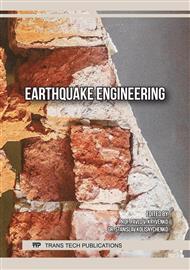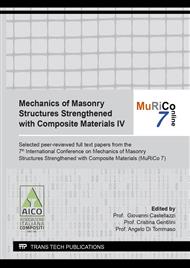p.222
p.230
p.239
p.249
p.256
p.267
p.275
p.283
p.289
Numerical Analysis of Masonry Structures through a Modified Composite Interface (MCI) Model
Abstract:
This paper presents an innovative modelling approach for evaluating the structural response of new and existing masonry buildings characterized by a periodic arrangement of units and mortar joints. The aim is to provide a calculation tool that allows to model the non-linear behaviour of masonry structures under lateral and vertical loads with a reduced numerical effort, without compromising the accuracy of the results. The proposed model is a typical D-FEM (Discontinuum - Finite Element Model) consisting of deformable blocks, which incorporates several masonry units. The blocks are separated by interface elements placed along predetermined surfaces on which cracks, sliding or crushing planes can develop. The surface layout is conceived to replicate all the fundamental failure mechanisms that can occur in real masonry structures. To adequately describe the non-linear behaviour of the interface elements, a Modified Composite Interface (MCI) model is formulated by modifying the "Combined Cracking-Shearing-Crushing" model originally proposed by Lourenço to simulate the cracking mechanisms along the interface elements of simplified micro-models in FEM analysis. The proposed D-FE model has been already calibrated and validated by the Authors on different masonry panels and, through an Evolutionary Polynomial Regression (EPR), expressions in closed form have been defined to calculate the mechanical parameters of the new MCI model starting from the original CI. Particularly, for each mechanical parameter, six formulas of increasing complexity have been identified through non-linear regression, progressively including a greater number of input variables to increase the precision of results. The aim of this study is to determine the accuracy of these formulas. Numerical analyses are carried out on a population of sixty-four masonry walls already used in the previous calibration phase, modeling each panel with all available equations. This allows to evaluate the average accuracy of each formula and to understand their efficiency in terms of calculation effort and correctness of the results.
Info:
Periodical:
Pages:
256-264
Citation:
Online since:
April 2022
Price:
Сopyright:
© 2022 Trans Tech Publications Ltd. All Rights Reserved
Share:
Citation:



